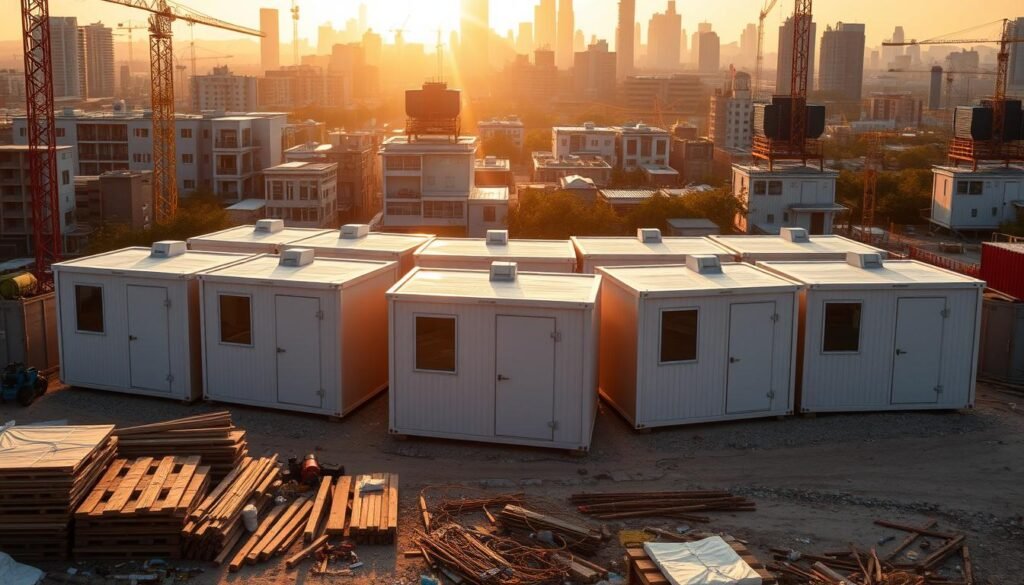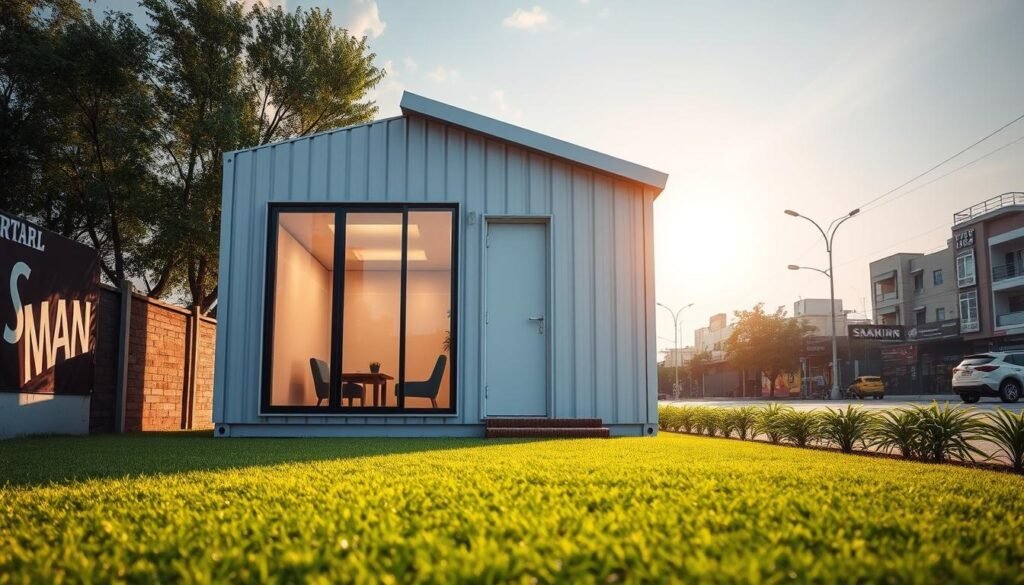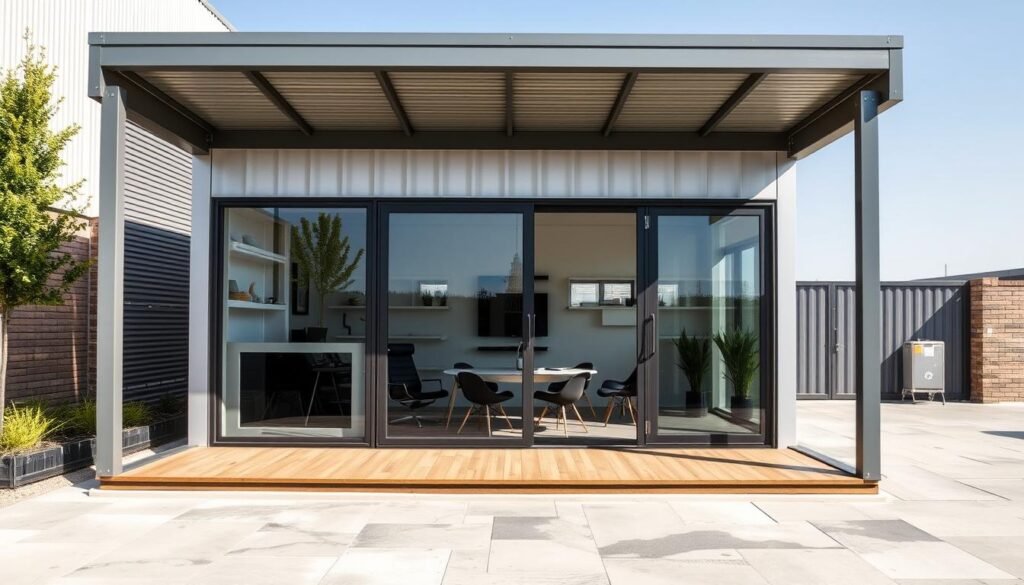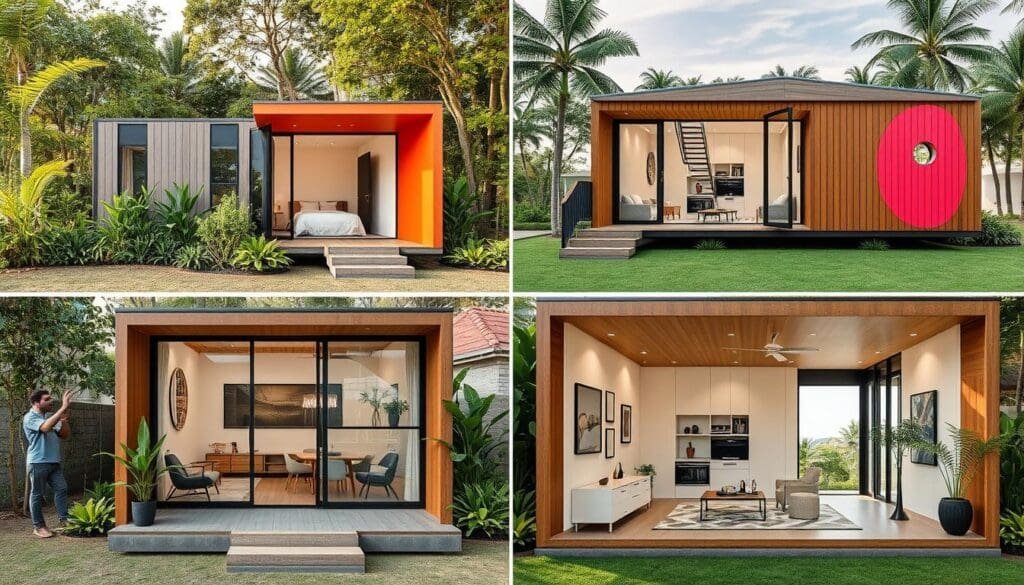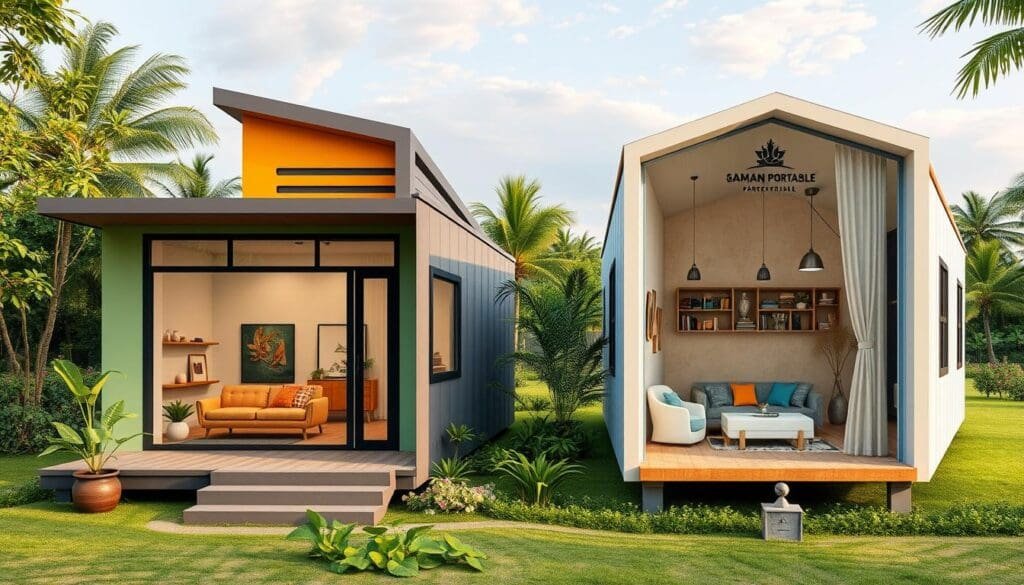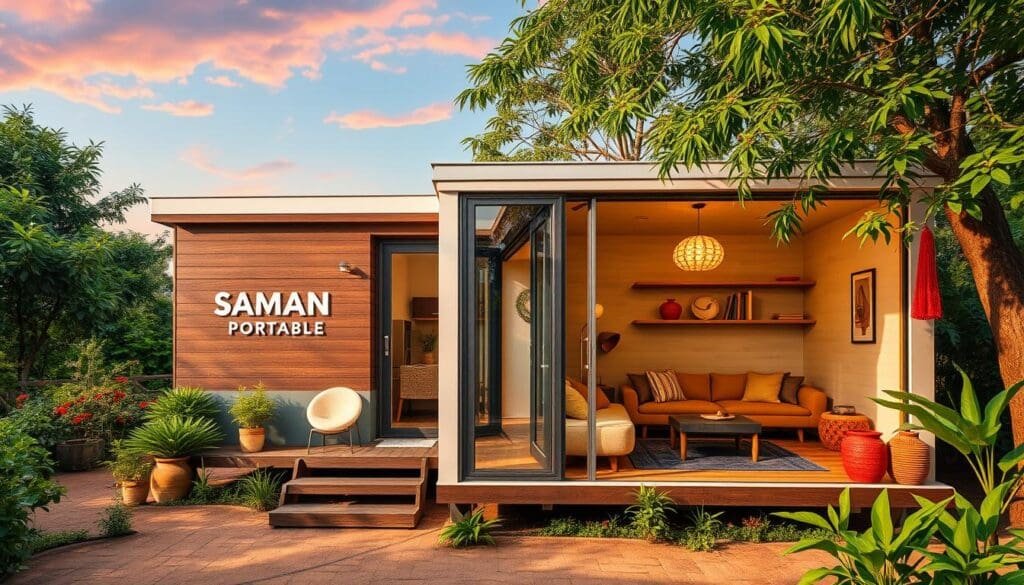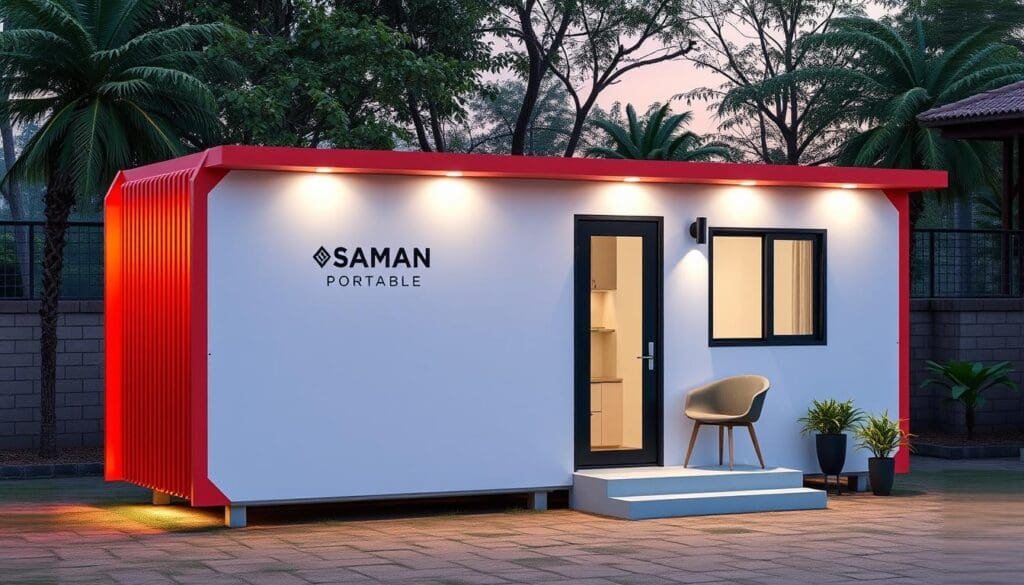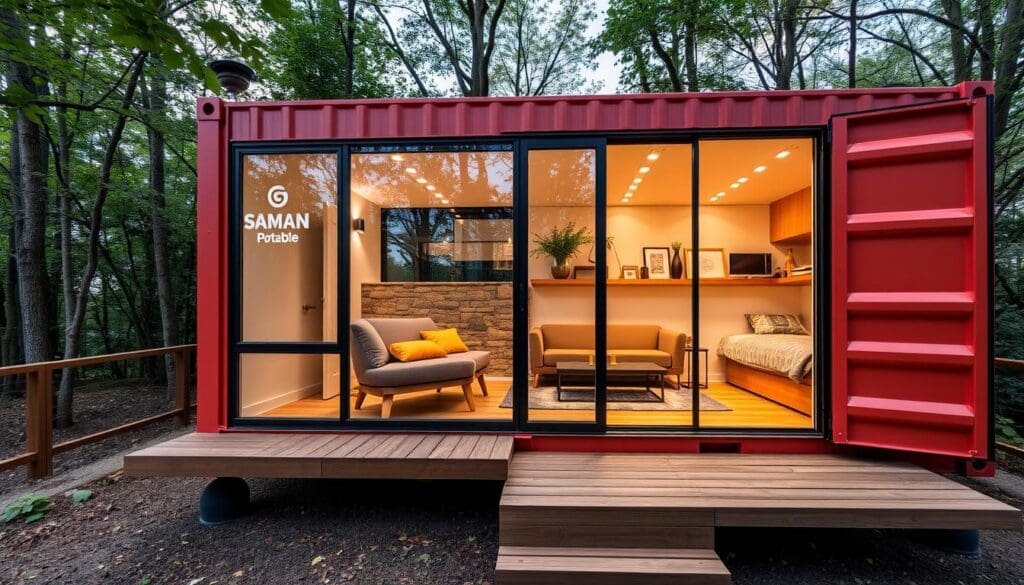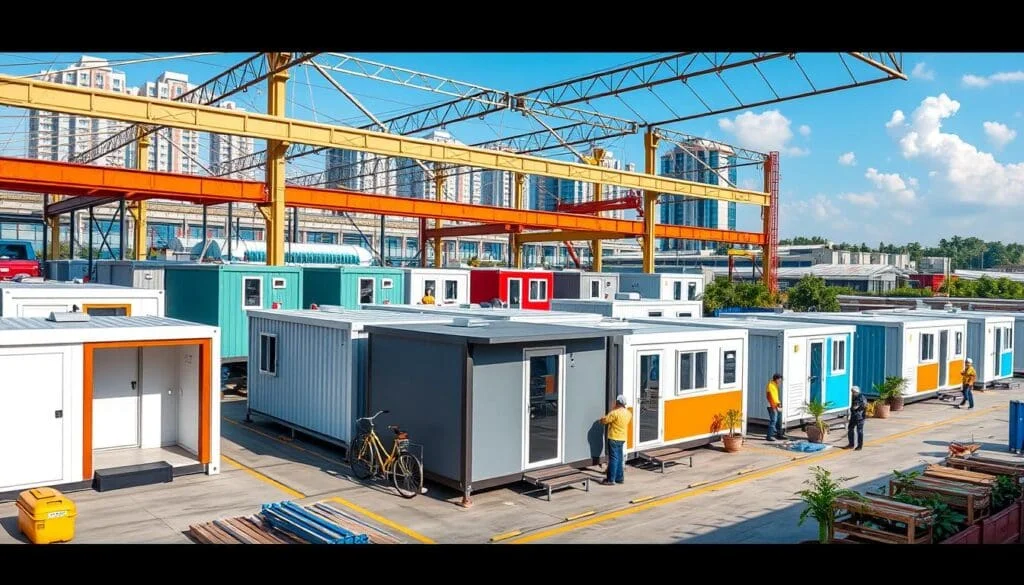Modular and Movable Homes: A Flexible Housing Solution

Introduction: The Rise of Modular and Movable Homes in India
The Growing Demand for Flexible Housing Solutions
In recent years, the demand for modular homes and movable homes in India has seen a significant rise, driven by changing lifestyle needs and increasing urbanization. With rapid urban growth and rising real estate prices, traditional housing solutions no longer meet the needs of many homeowners, especially those looking for affordable, customizable, and flexible housing options. Modular homes in India offer a perfect solution, combining convenience, cost-effectiveness, and speed with the added benefit of design flexibility. Similarly, movable homes provide unmatched mobility, allowing homeowners to relocate their homes as required.
Modular homes are prefabricated off-site, reducing construction time and minimizing disruptions to the surrounding environment. Their quick construction timelines make them ideal for people seeking a hassle-free housing solution. On the other hand, movable homes offer the unique advantage of portability. Whether you are a frequent traveler, a business owner requiring temporary housing, or someone looking to move between locations, movable homes provide the flexibility to adapt to your lifestyle without the permanence of traditional housing.
At Saman Portable, we offer a variety of flexible housing solutions, including container homes, prefabricated houses, and portable cabins, all designed to meet the growing demand for modern, efficient, and adaptable homes.
Why Modular and Movable Homes Are the Future of Housing in India
The traditional housing market in India faces several challenges, including high land prices, construction delays, and limited availability of affordable housing. Modular homes in India are designed to solve these issues by providing a faster, more affordable way to construct homes. Unlike conventional homes, modular houses in India are built in sections or modules in a factory and then transported to the site for assembly. This process significantly reduces construction times, saving both time and money while delivering high-quality homes that meet modern living standards.
In addition to modular homes, movable homes offer the added benefit of flexibility, allowing homeowners to relocate or repurpose their homes with minimal disruption. This makes them ideal for a wide range of applications, from mobile offices and construction site housing to temporary homes for individuals on the move.
As urbanization continues to accelerate across India, the demand for affordable, flexible housing solutions will only increase. The growing popularity of modular homes and movable homes reflects a shift towards a more dynamic, sustainable way of living. These homes provide an ideal balance between functionality, sustainability, and affordability, meeting the needs of modern homeowners in India.
If you’re considering a modular home or movable home, Saman Portable offers a range of prefabricated homes and porta cabins that can be customized to suit your specific needs. Whether you’re looking for a permanent residence or a temporary housing solution, we provide high-quality, adaptable homes to meet every requirement.
In conclusion, the rise of modular homes and movable homes in India represents the future of flexible housing solutions. With their affordability, speed of construction, and ability to be tailored to the needs of modern living, these homes offer a sustainable alternative to traditional construction methods. For more information on modular homes and movable homes, explore our range of portable cabins and other housing solutions. To learn more about our company and services, visit our about us page.
What Are Modular and Movable Homes?
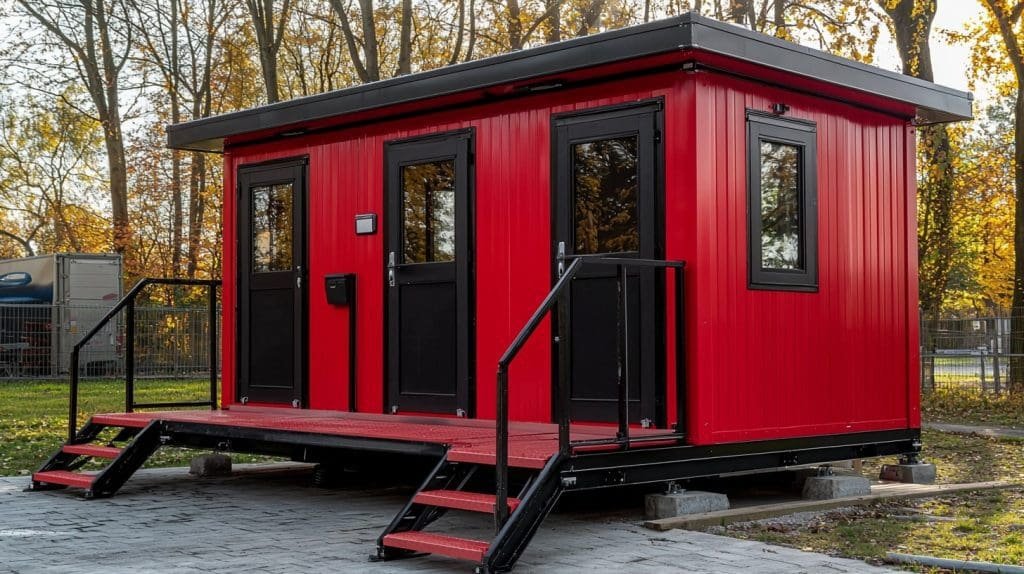
Understanding Modular Homes
Modular homes are a type of prefabricated housing where the home is constructed in sections or “modules” at an off-site factory. These modules are built with the same materials and standards as traditional homes but are produced in a controlled environment, which leads to fewer delays and higher precision during the construction process. Once the modules are built, they are transported to the construction site, where they are assembled on a foundation.
The main benefit of modular homes in India is that they offer a fast and affordable solution for home construction. As these homes are built in a factory, there is less exposure to weather-related delays, which can be a common issue for traditional on-site construction. Furthermore, modular homes are designed with sustainability in mind, often featuring energy-efficient designs and eco-friendly materials. Whether you’re looking for a compact home or a large, multi-story structure, modular homes offer a versatile solution for modern living.
At Saman Portable, we offer a range of modular homes that can be fully customized to suit your preferences and lifestyle, ensuring that you get a home that meets your needs, whether you’re in need of a permanent residence or a temporary office space.
Exploring Movable Homes
Movable homes are an innovative solution for those seeking a home that can be easily relocated. Unlike traditional homes, movable homes are not fixed to a permanent foundation, which makes them a perfect solution for individuals or businesses that require flexibility. These homes are typically mounted on trailers or chassis, allowing them to be moved from one location to another.
The primary advantage of movable homes is their mobility. Whether you’re a traveler, a construction worker, or someone in need of temporary housing, movable homes provide a flexible and convenient living solution. Additionally, movable homes can be used for a variety of purposes, such as portable offices, temporary housing, or even as holiday homes.
Saman Portable’s range of portable cabins and container homes includes designs that allow for easy relocation without compromising on comfort or quality. Whether you need a small, efficient movable home or a larger, more spacious option, we provide adaptable solutions to fit your needs.
Key Differences Between Modular and Movable Homes
While both modular homes and movable homes offer flexibility, there are key differences in their construction and purpose. Modular homes in India are often designed as permanent residences, built with the same structural integrity and longevity as traditional homes. They can be customized for long-term use, with various floor plans, layouts, and features available. The modular construction process allows for more complex designs and customization options compared to movable homes.
In contrast, movable homes are primarily designed for temporary living or relocation purposes. They are generally more compact and simpler in design than modular homes, and while they can be customized, they are often limited to more basic layouts. Movable homes are ideal for short-term housing needs, such as construction site accommodations, seasonal living, or as a mobile office solution.
Saman Portable’s prefabricated houses and porta cabins can be customized to meet various requirements, offering both long-term living solutions and temporary, movable housing options.
In conclusion, modular homes and movable homes both provide flexible housing solutions, but they serve different purposes. While modular homes offer permanent, customizable living spaces, movable homes provide mobility and flexibility for temporary housing needs. Whether you need a stable home or a versatile, relocatable structure, both options offer significant benefits. For more information on modular homes and movable homes, visit our about us page to explore the full range of housing solutions.
Key Differences Between Modular and Traditional Homes
Modular Homes vs. Traditional Construction: A Comparison
The modular homes industry has seen substantial growth in recent years due to the increasing demand for cost-effective, time-efficient, and customizable housing solutions. Compared to traditional construction, modular homes offer a number of key advantages. One of the primary benefits is the speed of construction. While traditional homes can take several months or even years to complete, modular homes in India can be assembled in a fraction of that time—sometimes as quickly as a few weeks. This accelerated timeline is possible because the modules are built in a controlled factory environment, reducing the risk of weather-related delays that often impact traditional home construction.
Moreover, modular homes offer consistent quality and craftsmanship. Since all modules are built in the same factory under strict quality controls, homeowners can expect a high level of precision and fewer mistakes than what is typically encountered in on-site construction. This quality control translates to reduced waste and a more sustainable approach to building, which is becoming increasingly important in today’s eco-conscious world.
In contrast, traditional homes require longer construction periods and are often subject to delays due to weather, availability of skilled labor, or challenges related to sourcing building materials. While traditional homes are typically built directly on-site, modular homes are delivered in pre-fabricated sections, and the on-site work is largely limited to the assembly of these parts.
At Saman Portable, we offer a range of modular homes and container homes that combine the benefits of quick construction with the flexibility of customized designs.
Cost-Effectiveness: Modular Homes vs. Traditional Homes
When it comes to cost, modular homes have a clear advantage over traditional housing. Modular houses in India are typically much more affordable than traditional homes due to the reduced labor costs, lower material waste, and faster construction times. Because modular homes are built in a factory setting, manufacturers can purchase materials in bulk, which often leads to savings that are passed on to the consumer. Additionally, the streamlined construction process reduces labor costs and eliminates the need for constant oversight, making modular homes a more budget-friendly option.
Another cost benefit of modular homes is their energy efficiency. These homes are often designed with energy-saving features, such as better insulation and high-quality windows, which can help reduce heating and cooling costs. In contrast, traditional homes may not have the same energy-efficient features unless homeowners specifically invest in them, which can add to the overall cost of construction.
While traditional homes may appear more affordable at first glance, their extended construction times and potentially higher ongoing maintenance costs can add up over time. For example, the ongoing labor costs for traditional homes during construction can significantly increase the final price, whereas modular homes in India offer a predictable cost structure from start to finish.
Saman Portable’s prefabricated houses and portable cabins provide affordable housing options that cater to different budgets without sacrificing quality or sustainability.
Flexibility and Customization: Tailoring Your Modular Home to Your Needs
One of the greatest benefits of modular homes in India is their flexibility and ability to be customized. Modular home India designs are highly adaptable, allowing homeowners to select various layouts, finishes, and features to create a space that suits their personal needs. Whether you are looking for a compact one-bedroom home or a large multi-bedroom house, modular homes offer designs that can be tailored to meet your specific requirements.
In addition to layout customization, modular houses in India can also be personalized with a variety of interior and exterior finishes. From flooring options to cabinetry, countertops, and roofing styles, modular homes offer a high degree of customization that is typically not possible with traditional homes. The modular construction process allows homeowners to select from a wide range of design options, ensuring that their home reflects their unique style and preferences.
In contrast, traditional homes often require significant alterations during the construction process to meet a homeowner’s preferences, which can increase costs and lead to longer construction times. Modular homes allow for a more streamlined and cost-effective approach to customization, ensuring that you get a home that fits your lifestyle.
For those who value flexibility and design freedom, modular homes are an excellent choice. Whether it’s designing a pre-fabricated house with a contemporary feel or a more traditional style, the options are virtually endless. To learn more about modular homes and the available customization options, explore Saman Portable’s prefabricated houses and modular homes.
In conclusion, the differences between modular homes and traditional homes are clear. Modular homes offer faster construction times, lower costs, and greater flexibility and customization, making them an ideal choice for those looking for a modern, efficient, and affordable housing solution. Whether you’re looking for a movable home or a permanent residence, modular homes provide a versatile and high-quality option. For more information, visit our about us page.
Advantages of Modular Homes Over Traditional Construction
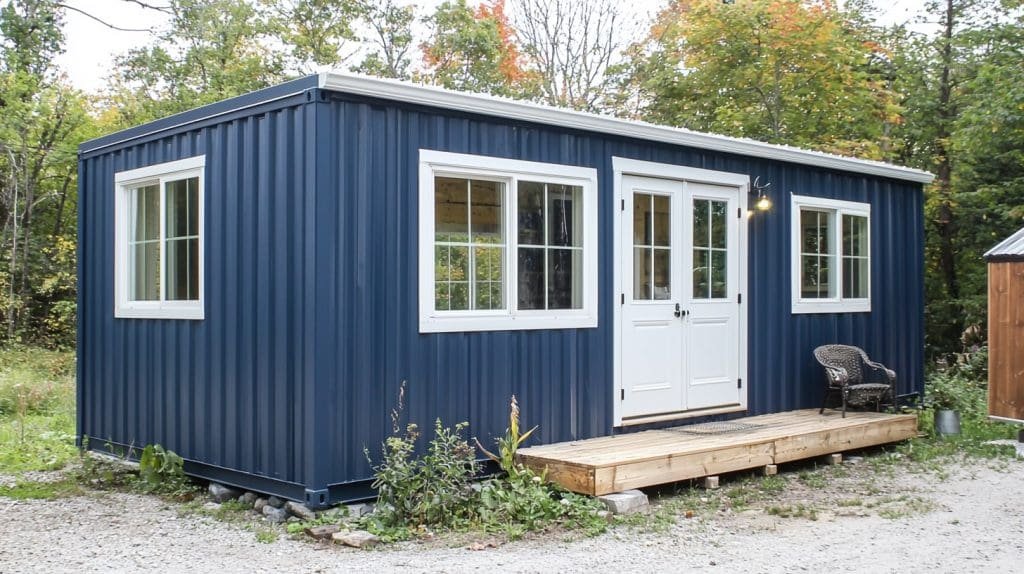
Cost-Effective Housing Solution
One of the primary reasons why modular homes have gained popularity in India is their cost-effectiveness. Modular homes in India are generally much more affordable compared to traditional construction due to several factors. First, the modular construction process takes less time than conventional building methods. Since much of the construction is done off-site in a factory, labor costs are significantly reduced. The factory setting also allows for bulk purchasing of materials, further reducing the overall cost.
Moreover, modular homes tend to have fewer material waste issues, as the factory setting allows for better control over the amount of materials used. In traditional construction, material waste is often high, contributing to increased costs. This is not the case with modular homes, where materials are efficiently used, reducing both waste and cost.
Finally, the shorter construction time for modular houses in India means that owners can move into their new homes much faster, which is especially valuable for those who need to minimize temporary housing costs. Whether you are looking for a prefabricated house for a small family or a larger multi-room home, the overall affordability of modular homes makes them a great investment.
At Saman Portable, we offer affordable and high-quality prefabricated homes and container homes that can be customized to meet your needs while staying within your budget.
Faster Construction and Quicker Occupancy
Another major benefit of modular homes is the speed at which they can be built. While traditional homes can take several months, even years, to complete, modular homes in India can be constructed in a fraction of the time. The reason for this is that modular homes are built in a controlled factory environment, where assembly lines can quickly and efficiently assemble the components. Once the modules are manufactured, they are transported to the site and assembled in a matter of weeks.
This faster construction timeline reduces the waiting time for homeowners and allows them to move into their new homes much sooner. This is especially advantageous for people who may be dealing with tight timelines or need to get settled quickly, such as people relocating for work or those with growing families.
In contrast, traditional construction methods often involve delays due to weather conditions, labor shortages, and the slow pace of manual construction. These delays increase the overall construction time and costs, making modular homes a more reliable and faster solution.
Saman Portable’s modular homes and portable cabins are designed for fast delivery and easy installation, making it possible for you to start living in your new home in no time.
Sustainability and Eco-Friendliness of Modular Homes
Sustainability is increasingly important to homeowners today, and modular homes provide an eco-friendly alternative to traditional homes. Since modular houses in India are manufactured in a controlled environment, there is less material waste and fewer emissions during the construction process. In addition, modular homes are often designed with energy-efficient features such as better insulation, energy-efficient windows, and systems for managing water and energy use.
Prefabricated homes are often built using sustainable materials, such as bamboo, recycled steel, and eco-friendly insulation, making them a greener choice than conventional homes. Many manufacturers are also incorporating renewable energy solutions, such as solar panels and wind turbines, into their designs, helping homeowners reduce their reliance on non-renewable resources.
Saman Portable’s container homes and modular homes include environmentally friendly features that minimize your carbon footprint while maintaining high standards of comfort and efficiency.
Customization and Flexibility of Modular Homes
Modular homes offer a high degree of customization, allowing homeowners to tailor every aspect of their living space to their personal preferences. From layout and floor plans to finishes and materials, modular homes in India can be designed to reflect your style and meet your functional needs. Whether you prefer a more traditional style or a modern, minimalist design, modular houses offer endless possibilities for creating a home that suits your taste.
One of the key advantages of modular homes is the flexibility they offer. Homeowners can start with a basic layout and add additional modules or expand their homes over time, depending on their needs. This makes modular homes ideal for growing families or businesses that may require more space in the future.
In contrast, traditional homes typically involve a fixed design, with little room for modification once construction begins. Customization in traditional construction is often costly and time-consuming, whereas modular homes offer a more streamlined and affordable way to create your perfect home.
Explore Saman Portable’s range of modular homes and porta cabins for customizable designs that meet your needs and preferences, while maintaining a quick construction timeline and budget-friendly pricing.
Conclusion: Why Choose Modular Homes Over Traditional Construction?
In conclusion, modular homes offer numerous benefits over traditional construction methods. They are cost-effective, faster to build, and highly customizable. The eco-friendly nature of modular houses in India makes them an ideal choice for homeowners who are looking for sustainability and energy efficiency. With quicker construction times and lower overall costs, modular homes provide an innovative solution to India’s housing needs, offering a flexible, efficient, and environmentally responsible alternative to traditional housing.
To explore the benefits of modular homes and learn more about how they can provide a perfect solution for your housing needs, visit Saman Portable’s prefabricated homes and container homes pages. For further information, check out our about us page.
Movable Homes: A Flexible Housing Solution for Dynamic Lifestyles
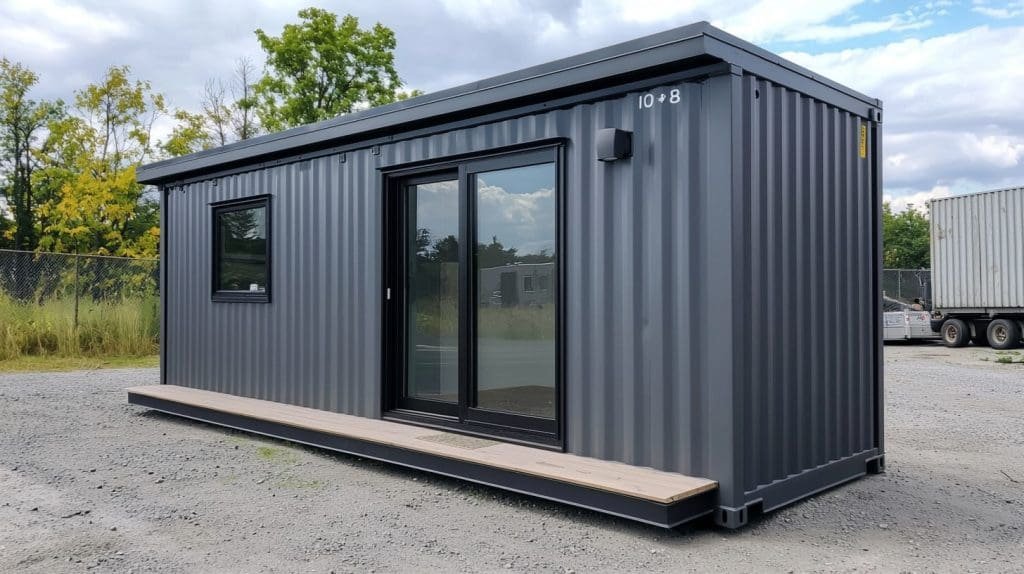
The Concept of Movable Homes
Movable homes are an innovative and flexible housing solution that provide homeowners with the ability to relocate their homes as needed. Unlike traditional homes that are fixed to a permanent foundation, movable homes are designed to be portable, often mounted on trailers or wheels, making them easy to move from one location to another. This mobility provides significant advantages for those who need housing that can adapt to changing circumstances, whether for work, travel, or temporary living arrangements.
The flexibility of movable homes makes them ideal for a wide range of situations. Whether you need a home that can be relocated due to work opportunities, a seasonal living space, or a temporary housing solution for a construction site, movable homes offer the freedom to adapt without the permanence of traditional homeownership.
At Saman Portable, we offer a range of movable homes and portable cabins that provide the flexibility and mobility you need for your dynamic lifestyle.
Advantages of Movable Homes
Movable homes offer several key benefits that make them an attractive choice for many homeowners. Here are some of the main advantages of choosing movable homes over traditional housing:
- Portability: The most obvious advantage of movable homes is their ability to be relocated. Whether you’re moving for a new job or simply want to change your surroundings, movable homes offer the flexibility to live anywhere without the need to sell or purchase new property.
- Cost-Effectiveness: Building and maintaining a traditional home can be expensive, particularly in areas with high land prices or limited housing options. Movable homes provide a more affordable alternative, as they are often less expensive to purchase and maintain than traditional homes.
- Flexibility: Movable homes are highly customizable to suit your needs, with options for different layouts, sizes, and designs. Whether you need a compact living space or a larger home with multiple rooms, movable homes can be tailored to fit your specific requirements.
- Temporary Housing: If you are in need of temporary housing, movable homes are an ideal solution. For instance, construction workers or project teams working on a site can use movable homes as onsite accommodations, avoiding the need for expensive hotels or renting local properties.
- Minimal Commitment: Traditional homeownership often comes with long-term commitments, such as mortgages, property taxes, and maintenance responsibilities. Movable homes offer a more flexible living arrangement that allows homeowners to avoid these long-term commitments.
Saman Portable’s container homes and modular homes are designed to be easily relocated, providing the perfect solution for people in need of flexible, portable housing.
Applications of Movable Homes
Movable homes are perfect for a variety of situations. Here are some of the most common applications:
- Construction Sites: For businesses or contractors working on long-term construction projects, movable homes can be used as temporary housing for workers, office space, or storage. This eliminates the need for costly rental properties or extended hotel stays.
- Traveling and Temporary Living: Whether you’re a frequent traveler or someone who likes to experience different parts of India, movable homes offer a great way to explore while still having the comfort and convenience of your own home. These homes can be set up anywhere, from the mountains to coastal areas.
- Seasonal Living: If you prefer to live in different regions based on the season, movable homes can offer a solution for seasonal living, providing comfortable accommodations wherever you choose to be. This is especially useful for those who live in areas that experience harsh winters or hot summers, as they can move their homes to more comfortable locations.
- Emergency Housing: Movable homes also provide an excellent solution in the event of a natural disaster or other emergency situations. In such cases, movable homes can be quickly set up as temporary shelters, offering safe and comfortable accommodations for displaced individuals.
Saman Portable’s Movable Home Solutions
At Saman Portable, we understand the need for flexible and affordable housing solutions. Our modular homes and movable homes are designed with convenience and mobility in mind, providing you with high-quality living spaces that can be relocated whenever necessary.
Whether you’re in need of temporary housing, looking for a mobile office solution, or simply want a flexible living space that adapts to your lifestyle, Saman Portable’s prefabricated homes and container homes provide the perfect solution. Our movable homes are built to the highest standards of quality and can be customized to meet your specific needs.
In conclusion, movable homes offer unparalleled flexibility, affordability, and convenience, making them the ideal solution for a variety of housing needs. Whether you’re looking for a temporary housing solution, a mobile office, or a flexible living arrangement, movable homes offer the freedom and adaptability that traditional homes cannot. To learn more about movable homes and how they can fit your needs, visit our about us page.
Customization Options for Modular Homes in India
Endless Design Possibilities for Modular Homes
One of the greatest advantages of modular homes is the ability to customize them to suit your unique style and needs. Modular homes in India offer an array of design options that cater to modern living preferences, from traditional aesthetics to contemporary, minimalistic designs. The customization process allows homeowners to personalize every aspect of their home, including the floor plan, materials, finishes, and features, creating a living space that truly reflects their vision.
With modular homes being built in sections or “modules” in a factory, customization is possible at every stage of the process. Whether you’re looking for a specific room layout, extra storage, or a particular type of flooring, modular homes can be easily tailored to meet your requirements. Additionally, modular homes can be expanded in the future if needed, allowing you to grow your living space as your family or business expands.
At Saman Portable, we offer a range of modular homes that can be customized to your preferences, giving you full control over your home’s design and functionality.
Interior Customization: Design Your Ideal Living Space
The interior of modular homes is where much of the customization happens. Whether you’re planning a cozy one-bedroom unit or a spacious multi-bedroom house, modular homes in India allow you to choose the interior layout that works best for your lifestyle. The flexibility of the design means that you can add extra rooms or reconfigure spaces as needed, ensuring that every corner of your home serves a purpose.
Customization options for the interior of prefabricated homes include:
- Room layouts: You can decide the number of rooms, their sizes, and their arrangement to suit your needs.
- Flooring options: Choose from a variety of flooring materials, including hardwood, tiles, laminate, or eco-friendly options.
- Kitchen and bathroom designs: Modular homes allow you to select the best fixtures, cabinets, and appliances for these essential spaces.
In addition, modular houses in India offer the ability to integrate eco-friendly materials into the interior, further enhancing the sustainability of your home.
Exterior Customization: Reflect Your Style with a Unique Design
The exterior of a modular home is just as important as the interior, as it gives your home its curb appeal and first impression. Modular homes in India offer several exterior customization options, ensuring that your home stands out while fitting seamlessly into its surroundings. Whether you prefer a modern look with sleek lines and contemporary finishes or a more traditional design with rustic elements, modular homes can be customized to meet any aesthetic.
Some exterior design features you can customize include:
- Roof styles: Choose between flat, sloped, or pitched roofs, depending on your design preference.
- Siding materials: Select from materials such as wood, vinyl, metal, or composite materials to achieve the look you want.
- Window and door styles: Opt for modern glass-pane windows, traditional wooden frames, or energy-efficient models to enhance both functionality and design.
Customization of the exterior also extends to the home’s foundation, which can be tailored to the type of land you own. Whether you need a raised foundation, a slab, or a full basement, modular homes can be designed to fit your location and lifestyle.
Eco-Friendly Customization Features
Sustainability is becoming a top priority for many homeowners, and modular homes are an excellent way to build an eco-friendly home without sacrificing comfort. Modular homes in India can be equipped with energy-efficient features that reduce your environmental footprint while saving on utility costs.
Some popular eco-friendly features you can incorporate into modular homes include:
- Energy-efficient insulation: Keep your home warm in winter and cool in summer without excessive energy use.
- Solar panels: Many modular houses are designed with solar panels or are solar-ready, allowing homeowners to reduce their reliance on grid power.
- Rainwater harvesting systems: Collect and store rainwater for irrigation or other non-potable uses.
- Eco-friendly materials: Choose sustainable materials such as bamboo, recycled wood, or low-VOC paints to make your home as green as possible.
Saman Portable’s modular homes and container homes are designed with sustainability in mind, offering customizable options for homeowners who want to make environmentally conscious choices.
Future Expansion: Growing Your Modular Home
One of the key advantages of modular homes is their ability to grow with you over time. Whether you need more space for a growing family or additional room for a business or hobby, modular homes can be easily expanded to meet your changing needs.
Unlike traditional homes, which often require extensive remodeling or reconstruction for expansion, modular homes in India can be simply expanded by adding additional modules. These modules are designed to fit seamlessly with the existing structure, making the process of expansion quick, affordable, and hassle-free.
Saman Portable’s prefabricated homes are designed with flexibility in mind, allowing for easy expansion or modification as your needs evolve.
In conclusion, modular homes offer a wide array of customization options, ensuring that you can create a home that perfectly matches your needs, budget, and style. From interior layouts to eco-friendly features and exterior finishes, modular homes provide a flexible and sustainable housing solution. Explore our range of modular homes and portable cabins for customizable living spaces that offer both comfort and versatility. For more details, visit our about us page.
Economic Benefits of Modular and Movable Homes
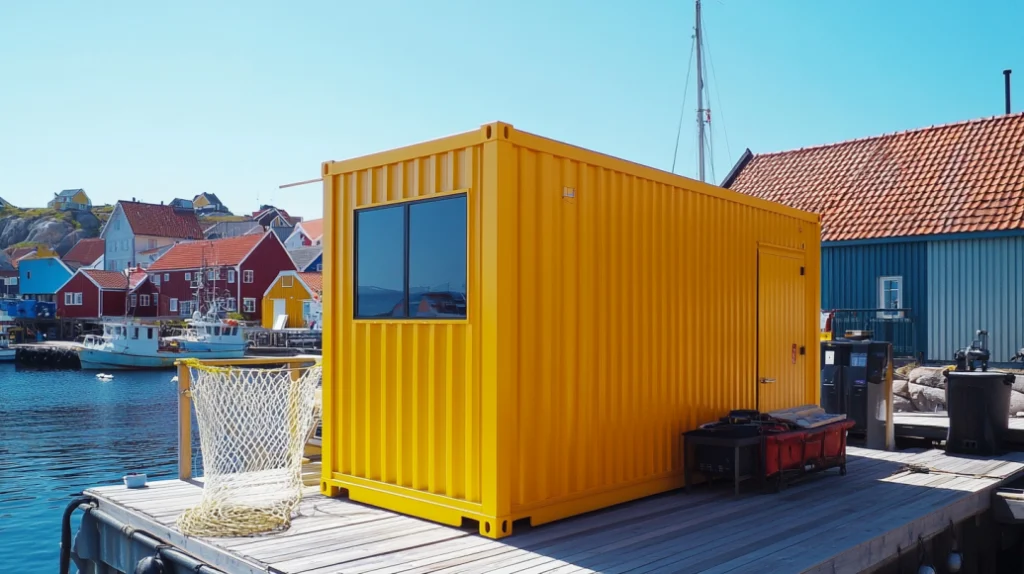
Affordability of Modular Homes
One of the biggest draws of modular homes in India is their affordability. Traditional homes, with their lengthy construction periods and complex processes, often come with high costs that make them inaccessible to many. In contrast, modular homes are constructed in a factory setting, reducing labor costs and material waste. Since much of the construction happens off-site, there are fewer delays, and the process is more streamlined, leading to significant cost savings.
Modular homes can also be a great investment because they are built with high-quality materials and modern construction techniques that ensure long-term durability. While modular homes may have a higher upfront cost than conventional prefab houses, the savings in construction time and labor can make them much more affordable in the long run. Moreover, their energy-efficient designs and customizable options can help homeowners save money on utilities and maintenance costs over time.
Saman Portable’s modular homes and container homes offer affordable housing solutions without compromising on quality, making them an ideal choice for homeowners looking for value for money.
Cost-Effectiveness of Movable Homes
Movable homes provide a cost-effective alternative to traditional housing, especially for individuals or businesses that require flexibility and portability. Since movable homes do not require a permanent foundation or extensive site preparation, their construction costs are much lower than traditional houses. The ability to relocate these homes reduces land-related expenses, and their portability allows homeowners to move to different locations without the financial burden of selling or buying new property.
Movable homes also save homeowners from paying high property taxes, as they often don’t carry the same taxation responsibilities as permanent residential structures. Whether you’re a seasonal worker, a traveler, or someone who simply enjoys the freedom to relocate, movable homes offer a cost-efficient housing solution without long-term commitments or ongoing costs.
Saman Portable’s portable cabins and movable homes provide an affordable and flexible solution for those seeking temporary or mobile housing.
Lower Maintenance and Operational Costs
In addition to being more affordable to build, modular homes and movable homes are also more affordable to maintain. Since modular homes are constructed in a controlled factory environment, they are less susceptible to the weathering and deterioration that can occur with traditional homes, leading to reduced maintenance costs over time. The materials used in modular houses in India are often chosen for their durability and resistance to damage, meaning fewer repairs and replacements are required.
Movable homes also have lower ongoing maintenance costs because they are designed to be resilient and easy to maintain. Many of these homes are built with materials that are resistant to wear and tear, ensuring that you won’t have to invest in expensive repairs. Additionally, modular homes often come with warranties for certain parts and materials, which can reduce the financial burden of ongoing repairs.
At Saman Portable, we offer modular homes and container homes that are built with high-quality materials designed to last, minimizing the need for constant upkeep and repair costs.
Affordable Customization for Every Budget
One of the key advantages of modular homes is their ability to be customized at various price points. Whether you’re working with a tight budget or have more flexibility, modular homes in India offer a wide range of customization options that can suit your needs. For example, you can opt for more basic designs, selecting affordable materials for flooring, finishes, and fixtures, or choose premium materials for a higher-end look.
Unlike traditional homes, where customization is often an expensive and time-consuming process, modular homes allow for customization during the initial design phase, giving you full control over your budget. This makes modular homes a practical solution for homeowners who want to personalize their space without breaking the bank.
Saman Portable’s prefabricated homes and porta cabins offer a range of customization options that fit various budgets, ensuring that you can create your dream home while staying within your financial constraints.
Investment Value and Long-Term Savings
Although the initial cost of modular homes may seem higher than traditional pre-fabricated houses, they offer significant long-term savings. The energy-efficient features of modular homes help lower heating and cooling costs, and the high-quality materials reduce the need for repairs and replacements. Additionally, because modular homes are built quickly and efficiently, they allow homeowners to start building equity sooner than they would with traditional construction.
Movable homes offer the advantage of portability, making them a great investment for those who want a flexible living solution. Whether you choose to relocate for work, travel, or seasonal living, movable homes provide long-term value and flexibility without the financial burden of moving or selling a traditional home.
In conclusion, modular homes and movable homes offer significant economic benefits, including lower construction costs, faster build times, and long-term savings on maintenance and utilities. Whether you’re looking for a cost-effective housing solution or a flexible living arrangement, these modern alternatives to traditional homes provide an affordable, sustainable, and customizable option. Explore Saman Portable’s range of modular homes and portable cabins for affordable, high-quality housing solutions. For more information, visit our about us page.
Technological Innovations in Modular and Movable Homes
Cutting-Edge Technologies in Modular Home Construction
Modular homes have embraced technological advancements that improve the quality, efficiency, and sustainability of the construction process. One of the key technologies driving the innovation of modular homes in India is Building Information Modeling (BIM). BIM allows designers and architects to create 3D models of homes before construction begins, providing a visual representation of the home and ensuring that all elements are well-coordinated. This results in fewer errors during the building process, reducing costs and time.
Furthermore, modular homes benefit from the integration of advanced manufacturing techniques that streamline the production process. These homes are constructed using automated systems in controlled factory settings, allowing for precision and high-quality craftsmanship. As a result, modular homes in India are consistently built to a higher standard than traditional on-site construction, with faster turnarounds and more accurate results.
Saman Portable’s modular homes are built using state-of-the-art technology, ensuring that each module is manufactured to exact specifications with high precision, reducing delays and offering superior durability.
Smart Home Technology in Modular Homes
Another significant technological advancement in modular homes is the integration of smart home technologies. Smart homes allow homeowners to automate various functions within their homes, including lighting, temperature control, security, and even appliances. As India’s urbanization continues to rise, the demand for smart homes has grown, and modular homes are increasingly incorporating these advanced features.
In modular homes in India, smart thermostats, security systems, and energy-efficient appliances are becoming standard. With the integration of smart home technology, homeowners can control their home’s functions remotely through mobile apps or voice-activated devices, improving convenience and reducing energy consumption. For instance, smart thermostats help maintain optimal temperature levels while minimizing energy use, which reduces utility bills.
At Saman Portable, we incorporate smart home solutions into our modular homes and portable cabins to enhance comfort, energy efficiency, and security, ensuring that homeowners experience modern living at its best.
Sustainable Technologies in Modular and Movable Homes
Sustainability is a major focus for modern housing, and modular homes are leading the charge in eco-friendly construction. Many modular homes in India now incorporate sustainable technologies that not only reduce the environmental impact of the building process but also improve the long-term sustainability of the home.
Some of the most prominent sustainable technologies found in modular homes include:
- Solar Panels: Many modular homes are designed to be solar-ready, or come equipped with solar panels to provide a renewable energy source that can lower energy bills and reduce the home’s carbon footprint.
- Rainwater Harvesting: Collecting and using rainwater for non-potable purposes, such as irrigation or flushing toilets, can significantly reduce water consumption and make a home more self-sufficient.
- Energy-Efficient Insulation: Advanced insulation materials, such as spray foam or eco-friendly cellulose, help keep homes warm in the winter and cool in the summer, reducing the need for heating and air conditioning and lowering energy consumption.
- Recycled and Eco-Friendly Building Materials: Modular homes often use sustainable materials, such as recycled steel, bamboo, or low-VOC paints, that contribute to a healthier environment both during and after the construction process.
Saman Portable’s container homes and prefabricated houses are built with sustainability in mind, offering homes that are not only energy-efficient but also environmentally responsible.
Prefab Homes and Robotics: The Future of Construction
The future of modular homes lies in the continued use of robotics and automation. Advances in robotic technology are making the construction of modular homes faster, safer, and more efficient. Robots are now being used in factories to assist in various tasks, including welding, painting, and assembly. These automated systems ensure that homes are built with precision, reducing the risk of human error and increasing the overall quality of the finished product.
In addition, prefabricated homes benefit from 3D printing technology, which allows for the rapid creation of complex structural components. This technology can help speed up the production of home parts, further reducing the time it takes to build modular homes. Additionally, 3D printing can be used to create custom designs or components, giving homeowners even more flexibility when it comes to personalizing their homes.
Saman Portable’s use of advanced manufacturing processes and cutting-edge technologies ensures that our modular homes are built to the highest standards of quality and efficiency, providing you with a modern, reliable, and eco-friendly living solution.
Conclusion: The Future of Modular and Movable Homes in India
Technology has played a pivotal role in revolutionizing the way modular homes and movable homes are built and customized. From advanced manufacturing techniques to smart home integrations and sustainable technologies, the future of housing in India is focused on innovation, efficiency, and sustainability.
As India’s housing needs continue to evolve, modular homes and movable homes offer a flexible, cost-effective, and eco-friendly solution that can meet the demands of modern living. By incorporating cutting-edge technologies, we can create homes that not only offer comfort and convenience but also help reduce our environmental impact.
Explore the future of housing with Saman Portable’s range of modular homes, container homes, and portable cabins, where technology, sustainability, and innovation come together to offer you the best in modern living. For more information, visit our about us page.
The Future of Modular and Movable Homes in India
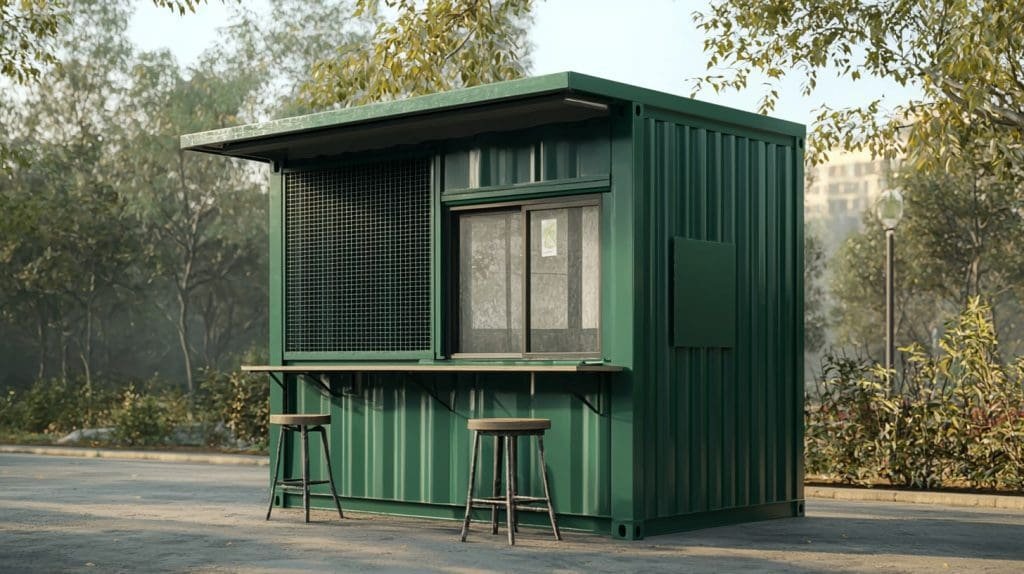
Growing Demand for Modular Homes in India
India is experiencing rapid urbanization, and the demand for affordable, efficient, and sustainable housing solutions is growing at an unprecedented rate. Modular homes in India are well-positioned to meet this demand, as they offer a cost-effective alternative to traditional construction methods. With housing shortages in urban areas and the increasing difficulty of acquiring land, modular homes provide a viable solution that can be scaled to meet the needs of a growing population.
Modular homes in India are not only a solution to affordable housing but also address the need for quicker construction timelines. Traditional construction can take years to complete, but modular homes can be built in a fraction of that time, reducing both costs and delays. This faster construction timeline makes it easier for developers to meet the growing demand for housing, especially in rapidly expanding urban centers.
Moreover, with the push toward sustainable living, more homeowners and businesses are looking for eco-friendly, energy-efficient solutions. Modular homes fit perfectly into this trend, offering homeowners the opportunity to live in a green, energy-efficient space. As India continues to grow and modernize, the demand for modular homes will only increase, offering a flexible, affordable, and sustainable housing option for all.
At Saman Portable, we offer a range of modular homes and container homes that provide a future-proof housing solution for those looking for a more efficient and sustainable way to live.
Government Support for Modular and Movable Homes
The Indian government has recognized the potential of modular homes as a solution to the housing crisis. Several government initiatives and policies are now in place to promote the use of prefabricated homes and modular homes in India. These initiatives are focused on providing affordable housing, improving urban infrastructure, and encouraging the adoption of sustainable construction practices.
For example, the government’s Housing for All initiative aims to provide affordable housing to millions of people in urban and rural areas. As part of this initiative, modular homes and movable homes are seen as a viable solution for low-income and middle-class families who cannot afford traditional homes. The adoption of modular homes is further supported by incentives for builders and developers to use sustainable and energy-efficient materials and construction methods.
Additionally, the government is providing subsidies and financial support to encourage the adoption of green technologies, such as solar panels and energy-efficient systems, in modular homes. This support makes modular homes even more affordable for those looking for eco-friendly housing options.
With continued support from the government and an increasing focus on sustainable development, the future of modular homes in India looks promising.
Innovation and Technological Advancements Shaping the Future
As technology continues to evolve, so too does the construction of modular homes. Advances in construction methods, materials, and digital tools are making it easier and more efficient to build modular homes. New materials, such as advanced insulation, recycled steel, and eco-friendly building products, are being integrated into modular homes, making them more energy-efficient, durable, and sustainable.
In addition, innovations in design software, such as Building Information Modeling (BIM), allow architects and builders to create highly detailed and accurate models of modular homes before construction begins. This helps to streamline the design process, reduce errors, and ensure a faster and more cost-effective construction timeline.
Automation and robotics are also playing a major role in the construction of modular homes. Robots are increasingly being used in the assembly process, performing tasks such as welding, painting, and finishing, with high precision. This reduces human error, increases speed, and further reduces costs, making modular homes even more affordable and accessible.
Saman Portable is at the forefront of incorporating these technological advancements into modular homes and movable homes, ensuring that our clients receive homes that are not only efficient and affordable but also built to the highest standards of quality.
The Future of Movable Homes: Portability and Flexibility
The future of movable homes is closely linked to the growing need for flexible living solutions. With more people choosing transient lifestyles due to work, travel, or personal preference, movable homes provide an ideal solution. These homes can be relocated easily, providing homeowners with the ability to move their homes wherever they need to go without the hassle and expense of traditional home sales or relocations.
The rise of the gig economy and remote work has made flexibility even more important. People no longer need to stay in one location for work, and movable homes provide the perfect solution for those who need to move frequently but still want the comfort of a permanent home. Whether you’re traveling for work, looking for a second home, or seeking seasonal living arrangements, movable homes offer unparalleled flexibility.
Additionally, movable homes are becoming more sophisticated, with the inclusion of modern amenities and smart home technologies. This makes it easier than ever for homeowners to enjoy the benefits of mobility without sacrificing comfort or functionality.
Conclusion: A Promising Future for Modular and Movable Homes
As we look to the future, modular homes and movable homes are poised to play a key role in India’s housing landscape. With their affordability, speed of construction, and sustainability, modular homes provide a solution to the growing demand for housing in urban areas. The integration of advanced technologies and government support further strengthens the case for modular homes, ensuring that these homes are not only a viable option for today’s homeowners but also a promising choice for future generations.
The growing popularity of movable homes and the increasing demand for flexibility and mobility in modern living further highlights the need for housing solutions that can adapt to changing lifestyles. Movable homes offer the flexibility to relocate while maintaining the comforts of home, making them an ideal choice for a diverse range of living needs.
At Saman Portable, we are committed to providing high-quality, customizable modular homes and movable homes that meet the evolving demands of modern living. To explore our full range of housing solutions and learn more about the future of modular homes, visit our about us page.
Conclusion: Why Choose Modular and Movable Homes for Your Future
The Future of Housing in India: Flexibility and Sustainability
The demand for modular homes and movable homes in India is only set to increase as the country continues to grow and urbanize. With rising property prices, limited availability of land, and the ongoing shift towards more mobile lifestyles, these flexible and sustainable housing solutions are emerging as the future of housing in India. Modular homes provide a solution to the housing crisis by offering affordable, energy-efficient, and quick-to-build homes. At the same time, movable homes are ideal for people who need to relocate frequently or prefer a lifestyle that emphasizes mobility and flexibility.
Both modular homes and movable homes offer significant benefits over traditional housing, including faster construction times, lower costs, and customization options. Whether you’re looking for a long-term living space or a temporary solution, these modern homes offer convenience, affordability, and adaptability, making them the perfect choice for today’s dynamic society.
The Cost-Effectiveness of Modular Homes
One of the key reasons to choose modular homes is the cost-effectiveness they offer. Modular homes in India are significantly more affordable than traditional brick-and-mortar homes, as they require less labor, fewer materials, and take less time to construct. The savings from quicker construction and efficient manufacturing processes are passed on to homeowners, making modular homes an ideal solution for those looking to build a quality home on a budget.
In addition, modular homes have lower maintenance costs over time. Built using high-quality materials and energy-efficient systems, modular homes are designed to be durable, sustainable, and low-maintenance, which saves homeowners money on repairs and utility bills.
Why Choose Movable Homes for Flexibility and Convenience?
Movable homes are an excellent solution for those seeking ultimate flexibility and convenience. Whether you need a home for temporary use, seasonal living, or a mobile office, movable homes can be relocated easily and set up at a variety of locations. This makes them ideal for individuals or businesses that require adaptable and portable housing solutions.
For example, movable homes are perfect for workers on construction sites or for people living in remote locations who need temporary housing. Additionally, movable homes provide the convenience of having your own space without being tied down to a permanent location, allowing you to move freely without the stress of selling a home or buying new property.
At Saman Portable, we offer a variety of modular homes and movable homes that cater to the needs of a diverse range of homeowners, whether you’re seeking a permanent residence or a flexible living space.
Customization Options to Match Your Needs
One of the most attractive features of modular homes is the ability to fully customize your living space. Modular homes in India can be designed to fit your personal style, functional needs, and budget. Whether you’re looking for a compact unit or a larger, multi-room structure, modular homes can be tailored to meet your exact specifications.
From floor plans and layouts to materials and finishes, customization is key to ensuring that your home meets your preferences and lifestyle. Movable homes also offer customization options, ensuring that you get a space that works for you, whether you’re creating a mobile office, a temporary home, or a vacation residence.
Sustainability and Eco-Friendly Features
Both modular homes and movable homes offer the opportunity to integrate sustainable and energy-efficient features. For those looking to reduce their environmental impact, modular homes in India provide an eco-friendly option by using energy-efficient materials, incorporating solar panels, and maximizing the use of natural light.
Movable homes also benefit from these sustainable features, offering options such as eco-friendly insulation and water-saving technologies. As sustainability becomes a priority for many, these homes provide an ideal solution for individuals who want to live in a way that supports a greener future.
Conclusion: Why Saman Portable is the Right Choice for Your Modular and Movable Homes
At Saman Portable, we offer a variety of modular homes and movable homes that are designed to meet the evolving needs of modern homeowners. Whether you’re looking for a flexible housing solution, a quick and cost-effective build, or an eco-friendly home, our products provide the perfect solution for all your needs.
With our commitment to quality, sustainability, and customer satisfaction, we are proud to be a leading provider of modular homes and movable homes in India. Our homes are built with the latest technologies, ensuring that you get a high-quality, energy-efficient, and customizable living space.
To explore the full range of modular homes and movable homes available, visit our website or get in touch with our team to discuss your housing needs. For more information, check out our about us page.
In conclusion, modular homes and movable homes are the future of housing in India. They offer unparalleled flexibility, affordability, and customization options, making them the perfect solution for today’s modern homeowners. Let Saman Portable help you create the home of your dreams!
 Container Cafe
Container Cafe
















































































